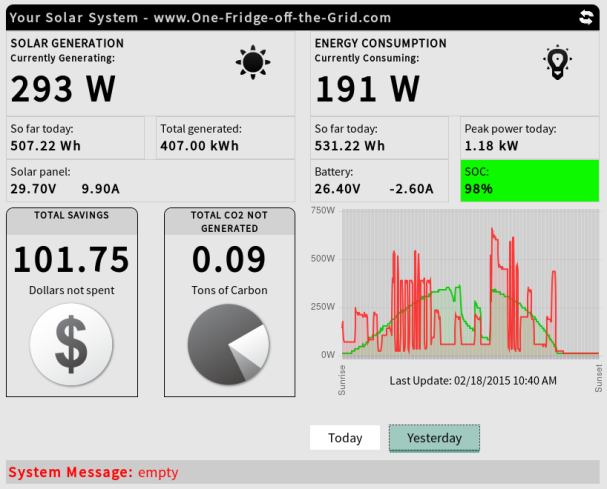Take your essential appliances off the grid with an Arduino-based solar UPS controller.
For his entry in the 2015 Hackaday Prize, Markus Loeffler recently developed a shoebox-sized UPS controller that can be used for solar energy on a minimal level. At the moment, the unit is capable of powering a handful of ‘always on’ household items like the refrigerator, Internet modem and home security system, thereby enabling users to take these appliances off the grid.
“It all started during a stormy winter in 2011 when my power was out for 4 days. I was thinking: if I only had some independent power source available. Maybe I would not have lost all my food in the fridge,” the Maker writes.
The device is not only modular and scalable, but can connect to any inverter, battery, charge controller and solar panel up to 1500W continuous power. The controller is essentially an Automatic Transfer Switch (ATS), which switches a load between two sources and will automatically be activated when it detects one of the sources has lost power.
“The controller is doing transfer switching between the solar powered inverter and main utility power to optimize battery life and maximize solar energy usage. It is also monitoring phase shift between utility power and inverter and only switches in phase-sync to protect your equipment.”
During day, the solar panel delivers power to the inverter and the excess energy charges the battery. At night, the inverter is turned off and the utility power from the wall outlet passes through. In the event of a blackout, the controller immediately kickstarts the inverter to power the 120V outlet. Meanwhile, UPS mode powers the inverter continuously for standby by drawing energy from the utility power to run the inverter and conserve battery life.
According to Loeffler, the run-time for the battery-operated UPS mode is contingent upon the type and size of batteries used, the rate of discharge, and the efficiency of the inverter. A wide variety of inverters and battery sizes can be combined, ranging from 10AH @ 12V to 5000AH @ 24V using common lead-acid batteries. The controller features a simple menu driven setup mode where levels for different kinds of battery types can be adjusted.
As for hardware design, Loeffler has “gone from breadboard proof-of-concept into actually manufacturing a small run of PCBs. Most of them are at friends houses who help beta-testing the system in combination with various inverters and charge controllers.”
The latest iteration follows in the footsteps of its initial ATmega2560 powered prototype, which the Maker had put to good use during Burning Man. The newer, more compact design replaces the megaAVR MCU with a simple plug-in connector for either an Arduino Nano (ATmega328) or Spark Core board.
The revised UPS controller now packs a 24VDC supply for external hardware with a max draw of 20W, header pins to communicate with other hardware, a buzzer, a temperature sensor, a 120V-24V transformer, six heavy-duty AWG terminals for connections, a 120V DPDT relay to switch between the two power sources, a power MOSFET bank to switch up to 50A @ 30VDC, as well as AC terminals for 10A @ 120VAC 60Hz.
“All parts together costs less then $900 and you can build a solar powered uninterruptible power supply (UPS) that generates you daily 1kWh or more,” Loeffler adds.
The Maker has put the system to the test by piloting the most recent controller throughout his household, which is being monitored as we speak. At the moment, the controller is powering his refrigerator, TV, stereo, phones and other mobile devices, laptop, desk lamp and IP setup.
Interested? Head over to the project’s official Hackaday.io page to learn more.



